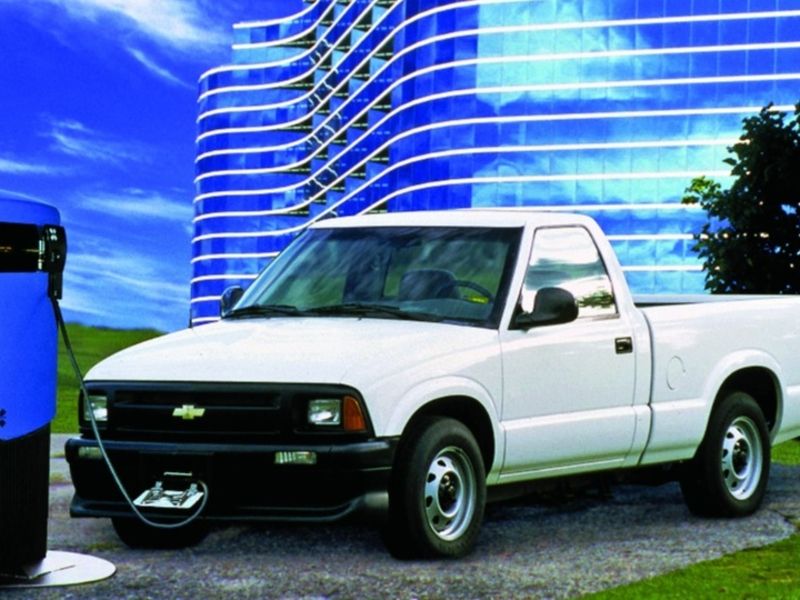
Historically, electric motors have not been a good fit for the American work horse, the pickup.
Electric trucks were available at the dawn of the auto industry and more recently from General Motors and Ford Motor Co. in the late 1990s as the companies worked to comply with California’s zero-emissions regulations.
Chevrolet’s S-10 Electric and Ford’s Ranger EV were limited in speed and range, and their cargo-hauling capabilities were diminished in part because they had to lug heavy battery packs. Today’s advanced technology has greatly improved all facets of performance on the coming wave of electric pickups from Rivian, Tesla, Ford, GM and others.
But some issues remain: With the possible exception of the uniquely styled Tesla Cybertruck, pickups are aerodynamically inefficient, meaning it takes a lot of energy to move them. That affects driving range. A battery pack can and often does weigh more than a conventional internal-combustion engine, transmission and drive axle. The battery pack alone in a Tesla Model S, for example, weighs 1,200 pounds, vs. about 675 pounds for a Ford EcoBoost V-6 engine and 10-speed automatic transmission.
The last generation of electric pickups was pitched mainly to fleet buyers, although small numbers were leased to environmentally minded consumers. The new trucks are aimed at a different audience.
“Initial EV truck sales will inherently go to buyers willing to make the changes necessary for an EV lifestyle,” IHS Markit analyst Stephanie Brinley said. “Buyers who are skeptical and not interested in making the switch to an EV truck won’t be swayed only by design. For them, it will take time and seeing the product prove themselves out. Plus, Rivian and Tesla will also have more traditional choices from Ford and GM to compete with as well.”
Here’s a look at two electrified pickups of the past.
In the late 1990s, GM was trying to amortize its huge investment in the powertrain for the EV1 coupe. To save money, engineers transplanted the EV1’s 114-hp motor and power electronics into the S-10. That may have doomed the program because the S-10 morphed from rear-wheel drive to front-wheel drive — a no-no for a body-on-frame pickup.
The 1997 model came with 27 lead-acid batteries under the bed, a pack that weighed 1,400 pounds. It pushed the S-10 Electric’s curb weight higher than that of some models of the full-size C/K 1500, the predecessor to today’s Silverado pickup. Driving range was around 38 to 45 miles on a charge.
The 1998 model got a nickel-metal hydride battery pack that saw driving range nearly double and its 0 to 50 mph time improved to 10.9 seconds while the top speed remained limited to 70 mph. It could haul 950 pounds, and charging times ranged from five to eight hours, depending on the battery pack.
The $33,305 price made the truck a tough sell, and GM dropped it at the end of the 1998 model year after a total production run of nearly 1,100.
This was a serious effort by Ford to make a vehicle that did more than simply comply with California’s zero-emissions mandate. Although the vehicle, introduced in 1998, used a standard Ranger body, Ford spent heavily on the powertrain, safety and creature comforts and made continuous improvements in its five years on the market.
The 1998-99 models were built with old- fashioned lead-acid batteries. The 39-cell pack nestled between the frame rails gave the Ranger EV a 50-mile driving range (at “optimal temperature,” according to a Ford brochure) before a six-hour recharge was needed. In cold weather, driving range plummeted. A full charge at 32 degrees was good for 35 miles.
The Ranger EV had a 90-hp electric motor and a single-speed transmission that drove the rear wheels. Ford said it could accelerate from 0 to 50 mph in 12.5 seconds and attain a top speed of 75 mph. The truck could haul 700 pounds.
It came with air conditioning, dual air bags, four-wheel antilock brakes and electro-hydraulic power steering. In 1999, Ford upgraded the batteries to lighter, more powerful nickel-metal hydride. The driving range increased to as much as 85 miles, depending on temperature, and hauling capacity improved to 1,250 pounds. Performance and charging times, however, were unchanged.
At launch, John Wallace, then Ford’s director of alternative fuel vehicles, said: “We’re in the EV business for the long term. We’re committed to making this work by providing good value.” Despite being offered in 22 states, only about 1,500 Ranger EVs were sold before Ford pulled the plug in 2002.
Ford’s next battery-electric vehicle, the Focus EV, didn’t arrive until 2012; it didn’t fare much better.